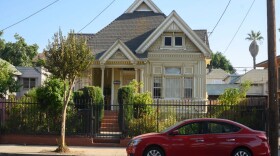Thick, brown and rust-colored, sticky oil is washing up on the beaches, marshes and wetlands of some parts of southern Louisiana, threatening wildlife and vital habitat. Those communities not yet seeing oil on their shores are bracing for the worst.
In the coastal waters of St. Bernard Parish, Louisiana Wildlife and Fisheries agents inspect areas of rich oyster beds and other critical habitat known as the Biloxi Marsh in Lake Borgne. There's no oil there yet, but it's coming, and there's an increasingly frantic effort to lay miles of boom to keep oil from getting into these marshes.
Local commercial fishermen, hired by BP, have been strategically anchoring the floating booms to protect the marshes. But agent Jason Russo says there often aren't enough booms to encircle an entire marsh, so they're placed around inlets and passes to keep oil from getting too deep into the reeds.
Pat Touchard is helping to coordinate the effort to protect the fragile islands and wetlands of St. Bernard Parish. He says in addition to placing booms, crews are out in the open waters near the Mississippi Sound, driving pilings into the sea bed to anchor more booms.
"It's another layer," Touchard says. "This whole concept is defense in layers and defense in strategies."
But after seeing oil the consistency of latex paint coating the reeds and grasses in the marshes of neighboring Plaquemines Parish, some officials are beginning to question the booming strategy.
"I don't know if this is going to be adequate to keep us safe. I doubt it," St. Bernard Parish spokeswoman Jennifer Belsom says.
"In our guts, we don't have a very good feeling, seeing what's happening next door to us in Plaquemines," she continues. "Hopefully somebody will step up to bat and say, 'This is what we're going to do' -- and do something a little more effective than just boom."
There is a growing uneasiness along these and other inner-coastal waterways in southeastern Louisiana as the threat to their environs and livelihoods grows ever more real.
"The oil is here," St. Bernard Parish President Craig Taffaro says. "That's an inevitable experience. What we don't know yet is to what extent -- to what intensity -- we'll experience it."
Taffaro says many of those who earn their living on the water feel like they've been sucker-punched by the oil spill, just four and a half years after almost being knocked out by Hurricane Katrina.
"The future of fishing don't look good," fisherman Don Menesses says. He looks worried as he pulls his boat in after an unsuccessful day fishing for speckled trout on some of the waters that still remain open to fishing. "I've been fishing this area since I was 9 years old."
Now 75, Menesses wonders if this might have been his last time fishing these coastal waters.
Copyright 2022 NPR. To see more, visit https://www.npr.org. 9(MDAzMjM2NDYzMDEyMzc1Njk5NjAxNzY3OQ001))







